 Is anybody there? Anybody? Anybody at all... Is anybody there? Anybody? Anybody at all...
|
| Republic of Indonesia Republik Indonesia (Indonesian) | |||||
|---|---|---|---|---|---|
|
|||||
| Motto: Bhinneka Tunggal Ika (Old Javanese) (English: "Unity in Diversity") National ideology : Pancasila |
|||||
| Anthem: Indonesia Raya (English: "Great Indonesia") |
|||||
| Capital (and largest city) | Jakarta | ||||
| Official language and national language |
Indonesian | ||||
| Ethnic groups | Over 1,300 ethnic groups | ||||
| Religion | 86.70% Islam 10.72% Christianity 1.74% Hinduism 0.84% Other |
||||
| Demonym | Indonesian | ||||
| Government | Unitary presidential constitutional republic | ||||
| - | President | Prabowo Subianto | |||
| - | Vice President | TBD | |||
| - | House Speaker | TBD | |||
| - | Chief Justice | TBD | |||
| Legislature | People's Consultative Assembly (MPR) | ||||
| - | Upper house | Regional Representative Council (DPD) | |||
| - | Lower house | People's Representative Council (DPR) | |||
| Independence | from the Netherlands | ||||
| - | Proclaimed | 17 August 1945 | |||
| - | Recognition | 27 December 1949 | |||
| Population | |||||
| - | census | 220.000.000 (estimate) | |||
| Currency | Indonesian rupiah (Rp) (IDR) |
||||
| Time zone | various (UTC+7 to +9) | ||||
| Date formats | DD/MM/YYYY | ||||
| Drives on the | left | ||||
| Internet TLD | .id | ||||
| Calling code | +62 | ||||
Indonesia, officially the Republic of Indonesia, is a country in Southeast Asia and Oceania between the Indian and Pacific oceans. It consists of around 14 thousand islands, with the islands of Java, Sumatra, Celebes (Sulawesi) and Borneo (Kalimantan). It holds a population of around 198 million people, becoming one of the most populous nations after Doomsday. Indonesia also has one of the worlds largest population of Muslims.
The sovereign state is a presidential, constitutional republic with an elected legislature and president. It has 34 provinces, of which five have special status. The country's capital, Jakarta. The country shares land borders with Sultanate of Aceh, Sultanate of Brunei-Sarawak, and East Timor. Other neighboring countries include Singapore, Philippines, Australia, and Papua New Guinea.
Indonesia consists of hundreds of distinct native ethnic and linguistic groups, with the largest one being the Javanese. A shared identity has developed with the motto "Bhinneka Tunggal Ika" ("Unity in Diversity" literally, "many, yet one"), defined by a national language, ethnic diversity, religious pluralism within a Muslim-majority population, and a history of colonialism and rebellion against it. Indonesia is a regional power in Southeast Asia and is considered a middle power in global affairs. The country is a member of several multilateral organizations, including the League of Nations
History[]
Pre-Doomsday[]
Prehistory[]

Homo Erectus
Fossilized remains of Homo erectus, popularly known as the "Java Man", suggest the Indonesian archipelago was inhabited two million to 500,000 years ago. Homo sapiens reached the region around 43,000 BCE. Austronesian peoples, who form the majority of the modern population, migrated to Southeast Asia from what is now Taiwan. They arrived in the archipelago around 2,000 BCE and confined the native Melanesian peoples to the far eastern regions as they spread east. Ideal agricultural conditions and the mastering of wet-field rice cultivation as early as the eighth century BCE allowed villages, towns, and small kingdoms to flourish by the first century CE.
Hindu-Buddhist civilizations[]
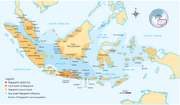
Map of Majapahit
The archipelago's strategic sea-lane position fostered inter-island and international trade, including with Indian kingdoms and Chinese dynasties, from several centuries BCE. Trade has since fundamentally shaped Indonesian history.
From the seventh century CE, the Srivijaya naval kingdom flourished due to trade and the influences of Hinduism and Buddhism. Between the eighth and tenth centuries CE, the agricultural Buddhist Sailendra and Hindu Mataram dynasties thrived and declined in inland Java, leaving grand religious monuments such as Sailendra's Borobudur and Mataram's Prambanan. The Hindu Majapahit kingdom was founded in eastern Java in the late 13th century, and under Gajah Mada, its influence stretched over much of present-day Indonesia. This period is often referred to as a "Golden Age" in Indonesian history.
Islamic states[]
The earliest accounts of the Indonesian archipelago date from the Abbasid Caliphate, according to those early accounts the Indonesian archipelago were famous among early Muslim sailors mainly due to its abundance of precious spice trade commodities such as nutmeg, cloves, galangal and many other spices.
Although Muslim traders first travelled through South East Asia early in the Islamic era, the spread of Islam among the inhabitants of the Indonesian archipelago dates to the 13th century in northern Sumatra. Although it is known that the spread of Islam began in the west of the archipelago, the fragmentary evidence does not suggest a rolling wave of conversion through adjacent areas; rather, it suggests the process was complicated and slow. The spread of Islam was driven by increasing trade links outside of the archipelago; in general, traders and the royalty of major kingdoms were the first to adopt the new religion.
Other Indonesian areas gradually adopted Islam, making it the dominant religion in Java and Sumatra by the end of the 16th century. For the most part, Islam overlaid and mixed with existing cultural and religious influences, which shaped the predominant form of Islam in Indonesia, particularly in Java. Only Bali retained a Hindu majority. In the eastern archipelago, both Christian and Islamic missionaries were active in the 16th and 17th centuries, and, currently, there are large communities of both religions on these islands.
Colonial era[]
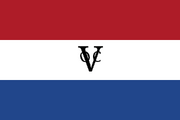
Flag of the Dutch East India Company
The first Europeans arrived in the archipelago in 1512, when Portuguese traders, led by Francisco Serrão, sought to monopolize the sources of nutmeg, cloves, and cubeb pepper in the Maluku Islands. Dutch and British traders followed. In 1602, the Dutch established the Dutch East India Company (VOC) and became the dominant European power for almost 200 years. The VOC was dissolved in 1800 following bankruptcy, and the Netherlands established the Dutch East Indies as a nationalized colony.
For most of the colonial period, Dutch control over the archipelago was tenuous. Dutch forces were engaged continuously in quelling rebellions both on and off Java. The influence of local leaders such as Prince Diponegoro in central Java, Imam Bonjol in central Sumatra, Pattimura in Maluku, and the bloody 30-year war in Aceh weakened the Dutch and tied up the colonial military forces. Only in the early 20th century did Dutch dominance extend to what was to become Indonesia's current boundaries.
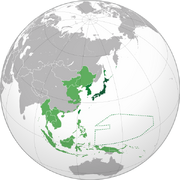
Japanese Empire at it's greatest extent
The Japanese invasion and subsequent occupation during World War II ended Dutch rule and encouraged the previously suppressed independence movement. Two days after the surrender of Japan in August 1945, Sukarno and Mohammad Hatta, influential nationalist leaders, proclaimed Indonesian independence and were appointed president and vice-president, respectively.
The Netherlands attempted to re-establish their rule, and a bitter armed and diplomatic struggle ended in December 1949 when the Dutch formally recognized Indonesian independence in the face of international pressure. Despite extraordinary political, social and sectarian divisions, Indonesians, on the whole, found unity in their fight for independence.
Post-WWII[]
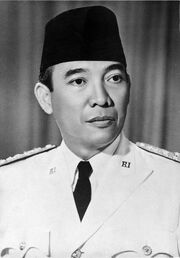
Soekarno
As president, Sukarno moved Indonesia from democracy towards authoritarianism and maintained power by balancing the opposing forces of the military, political Islam, and the increasingly powerful Communist Party of Indonesia (PKI). Tensions between the military and the PKI culminated in an attempted coup in 1965. The army, led by Major General Suharto, countered by instigating a violent anti-communist purge that killed between 500,000 and one million people. The PKI was blamed for the coup and effectively destroyed. Suharto capitalized on Sukarno's weakened position, and following a drawn-out power play with Sukarno, Suharto was appointed president in March 1968. His "New Order" administration, supported by the United States, encouraged foreign direct investment, which was a crucial factor in the subsequent two decades of substantial economic growth, which lasted until Doomsday.
Doomsday[]
Main article : Doomsday
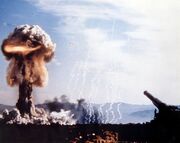
Nuclear bomb in Hawaii
On 26 September 1983, Soviet missile detection systems were alerted in what is believed to have been a false alarm. Incorrectly asserting that a foretold American first strike was occurring, the Soviet Union launched a full scale nuclear retaliation against the United States and her allies, promoting a similar American response. Causing a thermonuclear war.
Post-Doomsday[]
Immediate aftermath[]
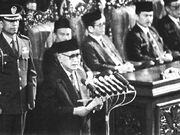
Suharto giving a speech informing the nation of doomsday
Indonesia was not hit by any nuclear warheads during doomsday, and media such as Radio and even television still functioned in most areas of the nation. But the news of the destruction of other countries created mass hysteria across the country. Riots and looting occurred in major cities, food shortages became rampant, and the destruction of the global market led to a financial crisis, as foreign investment became non-existent. This caused the collapse and bankruptcy of businesses and companies causing massive unemployment. Efforts by the central bank and the government, including raising fuel prices by 70% had little impact and arguably worsened the economic situation, not to mention the rioting it caused among the populace.

Rioters burning chairs in Jakarta
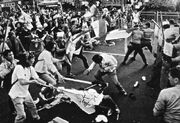
Riots in Bandung
Riots and looting continued in various parts of Indonesia, though things had calmed down by 1 October. Still, over the next few months, demonstrations, price riots, bomb threats, and bombings occurred and unrest was spreading to other islands.
Despite this, the government survived Doomsday, and began the process of rebuilding the nation and expeditions to find out what had happened to Indonesia's neighbors. These expeditions met the other expeditions conducted by the government of Singapore. Singapore reported the destruction of some capital cities, and some other countries which were stable, such as Australia. President Suharto met with Singaporean President Lee Kwan Yew in March 1984, leading to both nations agreeing on mutual defense and economic trade, this was followed by another visit to Malaysia, which resulted in mutual friendship between the two. President Suharto also met with Australian Prime Minister Bob Hawke, and agreed on mutual defence, mutual aid, and to begin economic trade. President George H. W. Bush of the remnants of the United Stats government also visited Indonesia in 1986, during his South East Asia trip, improving Indonesia's relationship with the West.
Civil War[]
Main article : Indonesian Civil War
Despite this cooperation between nations, Suharto and Indonesia as a whole had been weakened by the effects of Doomsday. In early October 1983, a series of pro-independence protesters in East Timor called for Indonesia to leave East Timor. Meanwhile, a series of pro-integration paramilitary groups of East Timorese began threatening violence—and indeed committing violence—around the province. The leaders of these militias warned of a "bloodbath" if Indonesia didn't leave. One paramilitary leader announced that a "sea of fire" would result in the event of Indonesia remaining in East Timor. Soon fighting began between the Indonesian military and the East Timorese paramilitaries. With towns being systematically razed and paramilitary groups attacking people and setting fires around the provincial capital of Dili.
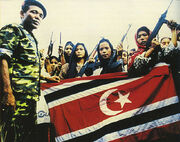
Female soldiers of the Free Aceh Movement
The outbreak of violence in East Timor would be followed with another insurgency in Aceh. The Free Aceh Movement (Indonesian : Gerakan Aceh Merdeka, GAM) took advantage of Doomsday, and re-established itself and began an insurgency in Aceh. The group raided for weapons, committed attacks against police and military posts, arsons and targeted assassinations of police and military personnel, government informants and other individuals. At first, GAM failed to gain widespread support, the group's actions led the Indonesian government to institute repressive measures, as the Indonesian military stepped up its counter-insurgency measures. Security crackdowns were also put in place,resulting in several thousand civilian deaths. The government launched an offensive and a state of emergency was proclaimed in the Province. These measures, although successful, alienated the local Acehnese which helped GAM re-establish itself in 1984, this time with large support from the Acehnese people.
Other rebellions also occurred, including an attempted Islamist rebellion in 1985 and an Independence rebellion in Southern Maluku in 1985, where the predominantly Christian population declared itself independent, and formed the Republic of Maluku. However, the Indonesian military were able to suppress both rebellions.
By 1986, East Timorese militias controlled 90% of the province, while GAM was able to control 70 percent of Aceh, and the war had turned into a stalemate. In 1987, the first ever dialogue process between the Indonesian Government and the East Timorese militias began. Followed by peace talks with both the East Timorese Militias and GAM. In 1988, a ceasefire was implemented in both Aceh and East Timor, and resulted in a reduction of armed clashes and violence.
Reform Era[]
Contemporary history[]
Geography[]
Indonesia lies between latitudes 11°S and 6°N, and longitudes 101°E and 134°E. It is the world's largest archipelagic country, extending 3,227 kilometers (2,005 mi) from east to west and 1,760 kilometers (1,094 mi) from north to south. The country's Coordinating Ministry for Maritime and Investments Affairs says Indonesia has more than 10,000 islands, scattered over both sides of the equator, around 3,000 to 3,500 of which are inhabited. The largest are Sumatra, Java, Borneo (shared with Brunei, though the Philippines hold the disputed territory of Sabah), and Sulawesi. Indonesia shares land borders with Brunei on Borneo and East Timor, an associated state of the Commonwealth of Australia and New Zealand located on the island of Timor, and maritime borders with Singapore, Malaysia, Vietnam, the Philippines, Belau, and Australia.
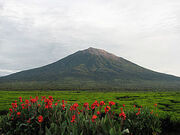
Mount Kerinci as seen from Kayu Aro
At 3,805 m meters (12,484 ft), Mount Kerinci is Indonesia's highest peak (which is shared with Aceh), and Lake Towuti in Southern Sulawesi is the largest lake, with an area of 561.1 km2 (216.6 sq mi). Indonesia's largest river is the Kapuas river, in Western Sumatra.
Climate[]
Indonesia lies along the equator, and its climate tends to be relatively even year-round. Indonesia has two seasons—a wet season and a dry season—with no extremes of summer or winter. For most of Indonesia, the dry season falls between May and October, with the wet season between November and April. Indonesia's climate is almost entirely tropical, dominated by the tropical rainforest climate found in every large island of Indonesia. More cooling climate types do exist in mountainous regions that are 1,300 to 1,500 meters (4,300 to 4,900 feet) above sea level. The oceanic climate (Köppen Cfb) prevails in highland areas adjacent to rainforest climates, with reasonably uniform precipitation year-round. In highland areas near the tropical monsoon and tropical savanna climates, the subtropical highland climate is prevalent with a more pronounced dry season.
Some regions, such as Kalimantan and Sumatra, experience only slight differences in rainfall and temperature between the seasons, whereas others, such as Nusa Tenggara, experience far more pronounced differences with droughts in the dry season and floods in the wet. Rainfall varies across regions, with more in Java, and the interior of Kalimantan, and less in areas closer to Australia, such as Nusa Tenggara, which tend to be dry. The almost uniformly warm waters that constitute a vast majority of Indonesia's area ensure that land temperatures remain relatively constant. Humidity is quite high. Winds are moderate and generally predictable, with monsoons usually blowing in from the south and east in June through October and from the northwest in November through March. Typhoons and large-scale storms pose little hazard to mariners; significant dangers come from swift currents in channels, such as the Lombok and Sape straits.
Geology[]
Tectonically, Indonesia is highly unstable, making it a site of numerous volcanoes and frequent earthquakes. It lies on the Pacific Ring of Fire where the Indo-Australian Plate and the Pacific Plate are pushed under the Eurasian plate, where they melt at about 100 kilometres (62 miles) deep. A string of volcanoes runs through Sumatra, Java, Bali and Nusa Tenggara, and then to the Banda Islands of Maluku to northeastern Sulawesi. Of the 400 volcanoes, around 130 are active. Between 1972 and 1991, there were 29 volcanic eruptions, mostly on Java. Volcanic ash has made agricultural conditions unpredictable in some areas. However, it has also resulted in fertile soils, a factor in historically sustaining high population densities of Java and Bali.
The 1815 eruption of Mount Tambora and the 1883 eruption of Krakatoa were among the largest in recorded history. The former caused 92,000 deaths and created an umbrella of volcanic ash that spread and blanketed parts of the archipelago and made much of the Northern Hemisphere without summer in 1816. The latter produced the loudest sound in recorded history and caused 36,000 deaths due to the eruption itself and the resulting tsunamis, with significant additional effects around the world years after the event.

Biodiversity and conservation[]
Indonesia's size, tropical climate, and archipelagic geography support one of the world's highest levels of biodiversity. Its flora and fauna is a mixture of Asian and Australasian species. The Sunda Shelf islands (Sumatra, Java, Borneo, and Bali) were once linked to mainland Asia and have a wealth of Asian fauna. Large species such as the Sumatran tiger, rhinoceros, orangutan, Asian elephant, and leopard were once abundant as far east as Bali, but numbers and distribution have dwindled drastically. Having been long separated from the continental landmasses, Sulawesi, Nusa Tenggara, and Maluku have developed their unique flora and fauna.
Indonesia has a large amount of endemic species. Tropical seas surround Indonesia's coastline. The country has a range of sea and coastal ecosystems, including beaches, dunes, estuaries, mangroves, coral reefs, seagrass beds, coastal mudflats, tidal flats, algal beds, and small island ecosystems. Indonesia is one of Coral Triangle countries with the world's most enormous diversity of coral reef fish.
British naturalist Alfred Russel Wallace described a dividing line (Wallace Line) between the distribution of Indonesia's Asian and Australasian species. It runs roughly north–south along the edge of the Sunda Shelf, between Kalimantan and Sulawesi, and along the deep Lombok Strait, between Lombok and Bali. Flora and fauna on the west of the line are generally Asian, while east from Lombok, they are increasingly Australian until the tipping point at the Weber Line. In his 1869 book, The Malay Archipelago, Wallace described numerous species unique to the area. The region of islands between his line and New Guinea is now termed Wallacea.
Indonesia's large and growing population and rapid industrialization present serious environmental issues. They are often given a lower priority due to high poverty levels and weak, under-resourced governance. Problems include the destruction of peatlands, large-scale illegal deforestation (causing extensive haze across parts of Southeast Asia), over-exploitation of marine resources, air pollution, garbage management, and reliable water and wastewater services.
Government and politics[]
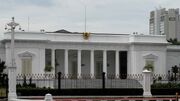
The Merdeka Palce, the main residence and workplace of the president
Indonesia is a Unitary presidential constitutional republic that consists of three branches of government, which are :
- Executive : The President of Indonesia is the head of state and head of government, commander-in-chief of the Indonesian National Armed Forces (Tentara Nasional Indonesia, TNI), and the director of domestic governance, policy-making, and foreign affairs. The president may serve a maximum of two consecutive five-year terms.
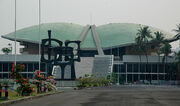
The People's Consultative Assembly building, where the People's Consultative Assembly meets
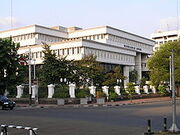
The Supreme Court Building, where the nation's highest courtsits
- Legislative : The bicameral People's Consultative Assembly (Majelis Permusyawaratan Rakyat, MPR), made up of the the People's Representative Council (Dewan Perwakilan Rakyat, DPR), with 535 members, and the Regional Representative Council (Dewan Perwakilan Daerah, DPD), with 106. Its overall functions are supporting and amending the constitution, inaugurating and impeaching the president, and formalizing state policy. The DPR passes legislation and monitors the executive branch. While the DPD is for matters of regional management.
- Judicial : The Supreme Court of Indonesia (Mahkamah Agung) is the highest level of the judicial branch and hears final cessation appeals and conducts case reviews. Lower courts, such as the State Court (Pengadilan Negeri) hears most civil disputes; appeals are heard before the High Court (Pengadilan Tinggi). Other courts include the Constitutional Court (Mahkamah Konstitusi) that listens to constitutional and political matters, and the Religious Court (Pengadilan Agama) that deals with codified Islamic Law (sharia) cases. Additionally, the Judicial Commission (Komisi Yudisial) monitors the performance of judges.
Parties and elections[]
Since the fall of the New Order regime and the reforms that followed, Indonesia has had a multi-party system. This has resulted in no political party managing to win an overall majority of seats, forcing parties to build coalitions to govern. The two largest parties are the Party of the Functional Groups (Golkar), which is the current governing party and the Indonesian Democratic Party (PDI). Other notable parties include the United Development Party, the National Awakening Party, and the Justice Party.
Administrative subdivisions[]
Indonesia has several levels of subdivisions. The first level is that of the provinces, with several having a special status. Each has a legislature (Dewan Perwakilan Rakyat Daerah, DPRD) and an elected governor. The second level is that of the regencies (kabupaten) and cities (kota), led by regents (bupati) and mayors (walikota) respectively and a legislature (DPRD Kabupaten/Kota). The third level is that of the districts (kecamatan, distrik in Papua, or kapanewon and kemantren in Yogyakarta), and the fourth is of the villages (either desa, kelurahan, kampung, nagari in West Sumatra, or gampong in Aceh).
The village is the lowest level of government administration. It is divided into several community groups (rukun warga, RW), which are further divided into neighbourhood groups (rukun tetangga, RT). In Java, the village (desa) is divided into smaller units called dusun or dukuh (hamlets), which are the same as RW. Regencies and cities have become chief administrative units responsible for providing most government services. The village administration level is the most influential on a citizen's daily life and handles village or neighborhood matters through an elected village head (lurah or kepala desa).
Foreign relations[]
Indonesia adheres to a foreign policy known as the "free and active" foreign policy. Where Indonesia seeks a role in regional affairs in proportion to its size and location but avoiding involvement in conflicts among other countries.
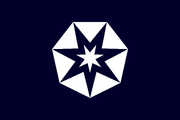
Flag of the League of Nations
Indonesia was a significant battleground during the Cold War. Numerous attempts by the United States and the Soviet Union, and the People's Republic of China to some degree, culminated in the 1965 coup attempt and subsequent upheaval that led to a reorientation of foreign policy. Quiet alignment with the Western world while maintaining a non-aligned stance has characterised Indonesia's foreign policy since then. Today, it maintains close relations with its neighbours and is a founding member of the Association of Southeast Asian Nations (ASEAN). Indonesia is also a member of the League of Nations. Indonesia was previously a member of the United Nations prior to the events of Doomsday. Though during the Indonesia–Malaysia confrontation, Indonesia withdrew from the UN due to the latter's election to the United Nations Security Council, although it returned 18 months later.
Military[]
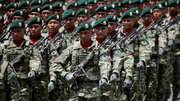
Indonesian Army
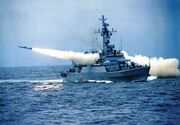
Indonesian navy
Indonesia's Armed Forces (TNI) include the Army (TNI–AD), Navy (TNI–AL, which includes Marine Corps), and Air Force (TNI–AU). The army has about 700,000 active-duty personnel. Defense spending in the national budget was 1.3% of GDP in 2018, with controversial involvement of military-owned commercial interests and foundations.
The Armed Forces were formed during the Indonesian National Revolution when it undertook guerrilla warfare along with informal militia. Since then, territorial lines have formed the basis of all TNI branches' structure, aimed at maintaining domestic stability and deterring foreign threats. The military has possessed a strong political influence since its founding, which peaked during the New Order. Political reforms in after the death of Suharto and the End of the New Order regime removed the TNI's formal representation from the legislature. Since then, the TNI's political influence has been radically reduced.
Since independence, the country has struggled to maintain unity against local insurgencies and separatist movements. After Doomsday, separatists in Aceh, East Timor, Maluku, and Papua resulted an armed conflict and subsequent allegations of human rights abuses and brutality. These conflicts have been mostly resolved, after a series of peace treaties. Other engagements of the army include the campaign against the Netherlands New Guinea to incorporate the territory into Indonesia, the Konfrontasi to oppose the creation of Malaysia, the mass killings of PKI, and the invasion of East Timor in 1975, which remains Indonesia's most massive military operation.
Economy[]
Demographics[]
Culture[]
Theatre and Cinema[]
Mass media and literature[]
Cuisine[]

tumpeng, the official national dish
Indonesian cuisine is one of the world's most diverse, vibrant, and colourful, full of intense flavour. Many regional cuisines exist, often based upon indigenous culture and foreign influences such as Chinese, European, Middle Eastern, and Indian precedents. Rice is the leading staple food and is served with side dishes of meat and vegetables. Spices (notably chilli), coconut milk, fish and chicken are fundamental ingredients.
Some popular dishes such as nasi goreng, gado-gado, sate, and soto are ubiquitous and considered national dishes. The Ministry of Tourism, however, chose tumpeng as the official national dish in 2014, describing it as binding the diversity of various culinary traditions. Other popular dishes include rendang, one of the many Padang cuisines along with dendeng and gulai. Another fermented food is oncom, similar in some ways to tempeh but uses a variety of bases (not only soy), created by different fungi, and is prevalent in West Java.
Sports[]

A demonstration of Pencak Silat, a form of martial arts
Sports are generally male-oriented, and spectators are often associated with illegal gambling. Badminton and football are the most popular sports. Indonesia is among the only five countries that have won the Thomas and Uber Cup, the world team championship of men's and women's badminton. Along with weightlifting, it is the sport that contributes the most to Indonesia's Olympic medal tally. On the international stage, Indonesia was the first Asian team to participate in the FIFA World Cup in 1938 as the Dutch East Indies. On a regional level, Indonesia won a bronze medal at the 1958 Asian Games.
Other popular sports include boxing and basketball, which has a long history in Indonesia and was part of the first National Games (Pekan Olahraga Nasional, PON) in 1948. Sepak takraw and karapan sapi (bull racing) in Madura are some examples of Indonesia's traditional sports. In areas with a history of tribal warfare, mock fighting contests are held, such as caci in Flores and pasola in Sumba. Pencak Silat is an Indonesian martial art.



